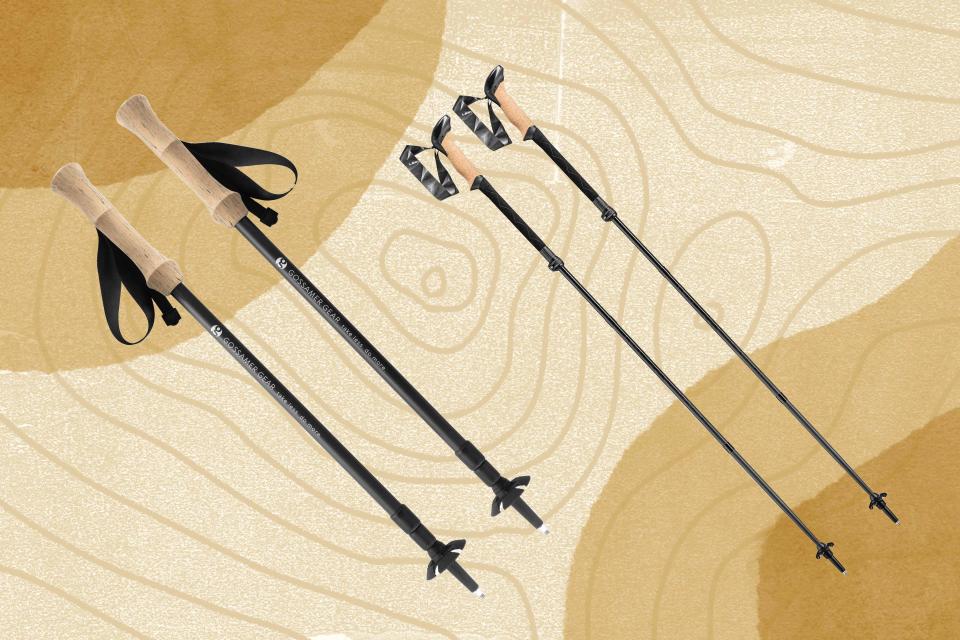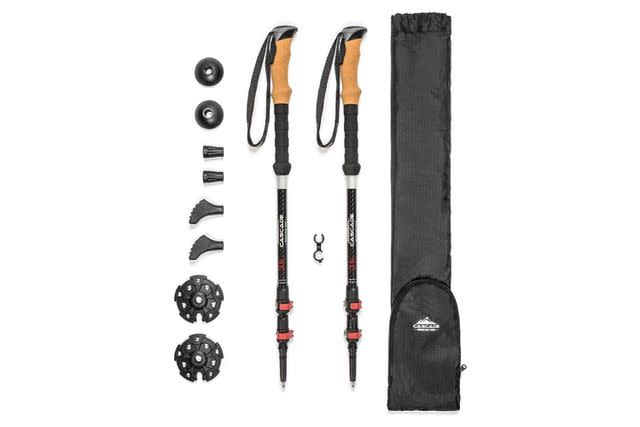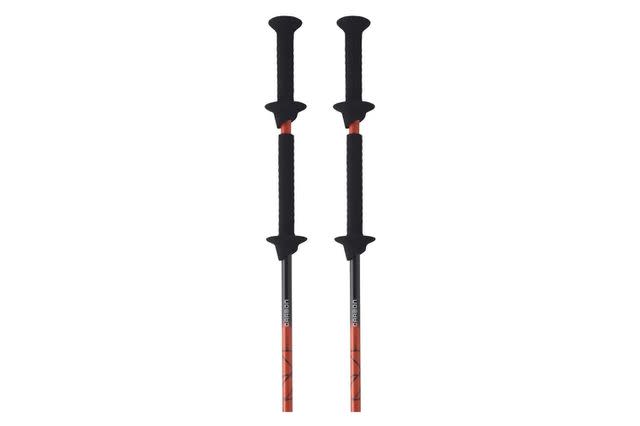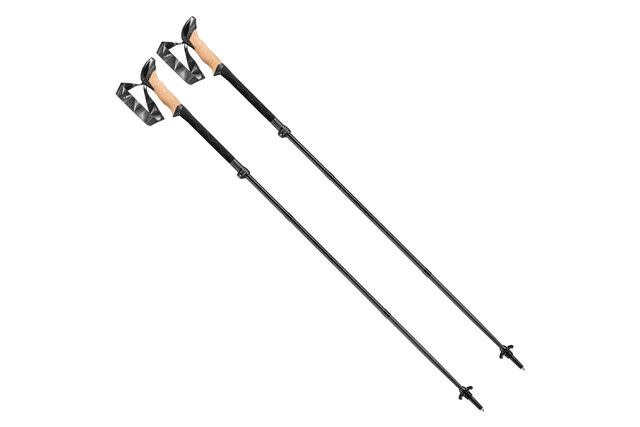The Best Trekking Poles for Every Hiker
Dotdash Meredith and Yahoo Inc. may earn commission or revenue on some items through the links below.
A great pair of trekking poles will boost your comfort and stamina on the trail — and spare you from some post-hike aches and pains.

Travel + Leisure / David Hattan
Trekking poles are an important — if sometimes overlooked — tool for backpackers and hikers. They help save your quads on steep ascents and take pressure off your joints on descents, and they’re an excellent balance aid on unpredictable terrain and water crossings.
“Trekking poles are great for easing pain and stress on knees and legs,” says Chris Meehan, a Colorado local who has authored multiple guidebooks, including Climbing Colorado’s 14ers. Meehan also says that trekking poles help elevate your hands, keeping swelling down at higher elevations.
The best trekking poles are lightweight with a bit of flexion to help absorb impact but are still sturdy enough for long hikes and multiple seasons. Look for poles that weigh no more than 1 pound for the pair and have reliable locking mechanisms with a range of height adjustments. The rubber, foam, or cork grips should be absorbent and comfortable, and the straps soft and easy to adjust. “Look for steel carbide tips for grip and durability,” says Meehan, “as well as removable baskets so you can interchange the baskets for snow or dirt.”
These are the best trekking poles on the market right now. For each set, we’ve listed the weight per pair, the range of lengths from collapsed to fully extended, as well as the shaft and grip materials.
Best Overall: Black Diamond Trail Trekking Poles

Why We Love It: They have an ideal combination of price, weight, and durability.
What to Consider: The foam grips can get somewhat slippery with sweat.
These classic, reliable poles from Black Diamond aren’t the company’s fanciest or lightest trekking poles, but they nabbed our Best Overall accolade thanks to their combination of dependable locking mechanisms, range of adjustability, and sturdiness on trail. Built with relatively lightweight aluminum shafts, these poles are super durable both in materials and mechanics, meaning they won’t collapse on you no matter how steep the descent. These collapse down to 25 inches and have an extended range of 39 to 55 inches, long enough for hikers on the taller side. While aluminum doesn’t have the same swing feel and absorption as carbon, we often prefer this material for the added durability. If you get these wedged between two rocks, you probably won’t risk snapping them when you pull them out, and they can take a serious beating on rugged terrain. Plus, even with the relatively low price and simpler design, these poles still weigh just 8 ounces each. They also come in a women’s-specific model that extend to 53 inches and have a slightly modified grip.
Price at time of publish: $120
The Details: Aluminum, foam | 25-55 | 1.06 pounds
Best Budget: Cascade Mountain Tech Carbon Fiber Trekking Poles

Why We Love It: These are lightweight carbon fiber poles at a very reasonable price.
What to Consider: The locking mechanisms can come loose; remember to tighten them before trips.
Clocking in at just over 6 ounces per pole, these affordable carbon fiber trekking poles can stand up to the specs of higher-priced name brands. These are similar in telescoping design as the Black Diamond Trail poles, but Cascade Mountain saves in material and construction cost by only having two sections instead of three. This makes them a few inches longer when fully collapsed, but if that’s the main design difference, we’ll take it. They have a similar flick lock to other telescoping models, and while we did have to tighten the bolts after a few backpacking trips, they were quite secure and quick to adjust for ascents and descents. Choose from full EVA foam grips or a combination of cork and foam. These have extended grip sections so you can choose a comfortable position without having to extend or collapse the poles, and they have Meehan’s recommended carbide tips for extra grip on rocky terrain.
Price at time of publish: $55
The Details: Carbon, foam, cork | 30-52 inches | 12.2 ounces
Related:The 10 Best Daypacks for Hiking in 2023, Tested and Reviewed
Best Ultralight: Gossamer Gear LT5 Carbon Trekking Poles

When we need a lightweight set of poles that rebounds beautifully off the trail and has an effortless swing, this is our go-to pair. The LT5 poles from the ultralight experts at Gossamer Gear are not only some of the lightest on the market, they’re incredibly comfortable to use over the course of an extended trip. They save weight by using slim twist locks on the adjustable sections as opposed to flick locks, and if you tighten them enough without going overboard, they’ll stay at your preferred length without coming unsecured. Just be careful on sandy or dusty trails, as the twist lock can get clogged and gritty, and you might have to pull the poles apart for post-trip cleaning. The main concern with these poles is that they will snap if they get caught between rocks and wrenched out with lateral force on the carbon shaft. This can be avoided by staying aware of your pole plant, and as soon as you feel the pole get stuck, stop and pull it directly up and out instead of pulling it forwards towards you.
Price at time of publish: $156
The Details: Carbon, foam | 23.5-51 inches | 9.8 ounces
Best All-season: TSL Move Carbon/Alu 2 Swing Poles

Why We Love It: They’re durable enough for winter outings but light enough for summer hikes.
What to Consider: The 33-inch collapsed length makes these less portable than other models.
Meehan recently brought a pair of TSL poles on a backcountry trek to Zion, stashing them easily in his pack and using their reliable support to pitch his trekking pole tent at camp. These rugged (but still lightweight!) poles were designed to provide stability, traction, and propulsion on snowy trails but can easily switch over to summer hiking and backpacking with a quick basket swap. The winter-ready baskets are a generous 85 millimeters, and you can actually adjust the angle of the baskets to provide the best assistance on varying slope degrees. The grips look different than other poles, with two levels of support and extended EVA foam for extra stability on changing terrain, and the two ledges can also reduce hand fatigue since your hands won’t stay in the same position for the duration of the outing. In the summer, remove the baskets to save weight and the tungsten carbide tips will provide more than enough dig and grip on rock and dirt trails.
Price at time of publish: $98
The Details: Aluminum, carbon | 33-51 inches | 16 ounces
Best for Portabilitiy: Leki Black Series FX Carbon Trekking Poles

Why We Love It: These poles are light and flexible with good top-section adjustability.
What to Consider: The full-extension locking mechanism isn’t super intuitive at first.
Z-fold poles are an excellent choice for hikers who like to use poles on trickier trail sections but leave them stashed in a pack or side pocket on moderate terrain. This pair from Leki collapses down to just 16 inches, unfolding and snapping into place in seconds. Once extended, the adjustability for use comes from a flick lock in the top section, with a minimum extension of 43 inches and a maximum extension of 51 inches. While this is less of a range than many telescoping poles, it will still work for hikers from just over 5 feet to 6 feet tall. The cork grips are excellent for sweat absorption, and Leki has some of the most comfortable wrist straps of any poles we’ve tested. These have become our go-to poles thanks to their convenience and ergonomic feel, though the top locking mechanism did take us two trips to get used to. The trick is extending the pole, snapping the sections together, then pulling the top section until the green “lock” band is exposed. From there, twist it until the pieces lock firmly together.
Price at time of publish: $270
The Details: Carbon, cork | 16-51 inches | 16 ounces
Tips for Buying Trekking Poles
Consider grip material and contour shape
Trekking pole grips are most often made with cork, foam, or rubber. Some poles have a combination of the three, and the most common materials are cork and foam. Some hikers prefer cork grips since they mold better to your hands, though they can feel more slippery if your hands tend to sweat a lot on hot hikes. Foam is highly absorbent and lightweight, and while it won’t mold as well over an extended period of time, many hikers prefer the softness of the foam and the higher absorption. Rubber is the least common grip material and is more often used in heavier poles for cold weather. Most trekking pole grips are built with hand-shaped ergonomics in mind, with a range of grip positions for maximum comfort. Some poles we listed have extended grip sections for more adjustability and range of positions, which helps ease fatigue.
Don’t forget about packability
All of the poles we listed are telescoping with two or three sections, or Z-fold with three sections. This means they can collapse down in seconds for stowing in a pack or side pocket and are easy to transport in cars or luggage. Z-fold poles often fold down smaller than telescoping poles, but both are quite portable. Consider how you want to transport your poles and if minimum collapsed size is important for your travel. That will impact the model you choose, as even in our roundup the minimum collapsed size ranges from 16 inches to over 30 inches. If you plan to fly with your poles, be prepared to check a bag, as many airlines won’t allow trekking poles as a carry-on item.
Related:The 10 Best Hiking Shorts for Women of 2023
Look for extra features
Trekking poles are fairly straightforward, but you’ll want to consider the material and ease of adjustment for the wrist straps, the grip material, and the design of the poles. Do you want Z-fold or telescoping? The lightweight feel of carbon or the higher durability of aluminum? Check out what comes in the package as well — many sets of poles come with interchangeable baskets, with smaller baskets for sand and dirt, wider baskets for snow, and the ability to hike without baskets for tougher ground. If you think you’ll be using the poles as a year-round accessory, look for a set with snow baskets, and if traveling fast and light in the summer is your priority, you’ll be better off with an ultralight pair and smaller baskets.
Frequently Asked Questions
What size trekking poles should I buy?
Since most trekking poles are adjustable, size ranges are fairly limited and the length comes from adjusting for your height. As a rule, your hands should rest comfortably on the grips with your elbows bent at a 90-degree angle. Some hikers adjust poles to be longer or shorter for steep climbs and descents, maintaining that 90-degree bend. Length depends on your individual proportions, so it’s hard to say exactly how long your poles should be, but most hikers will be fine with poles that adjust between 40 inches and 52 inches. Some poles with a limited adjustment range offer size options (small/medium and large/extra-large), but be sure to look at the extended length specs before purchasing. Additionally, if you are using your hiking poles to set up a tarp-tent style shelter, read the pitch requirements and choose poles that extend to the correct length.
Are trekking poles the same as hiking poles?
Trekking poles and hiking poles are often used interchangeably to describe the same type of supportive hiking aid. Occasionally the term “trekking pole” will be used for more rugged sets best for off-trail excursions, but most of the time trekking poles and hiking poles are referring to the same thing.
Why Trust Travel + Leisure
Maggie Slepian is an avid hiker, backpacker, and trail runner with more than a decade of professional gear testing experience. She has backpacked thousands of miles, and her hiking and backpacking has taken her from winter peak bagging to coastal backpacking to extended trips in the desert and high alpine. Maggie is also a professional gear tester, testing hundreds of items on the trail each year, from hiking shoes to headphones to protein bars. Her gear and apparel is tested in all four seasons and in a range of environments and climates.
Related:The 16 Best Hiking Shoes and Boots of 2023
Love a great deal? Sign up for our T+L Recommends newsletter and we'll send you our favorite travel products each week.
For more Travel & Leisure news, make sure to sign up for our newsletter!
Read the original article on Travel & Leisure.

